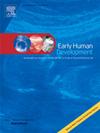母亲抑郁轨迹与八个月婴儿神经发育之间的关系。
IF 2.2
3区 医学
Q2 OBSTETRICS & GYNECOLOGY
引用次数: 0
摘要
背景:越来越多的人认识到,产妇抑郁是导致儿童神经发育障碍的一个风险因素。很少有研究调查了产妇抑郁的严重程度和持续时间与儿童发育之间的关系。我们旨在确定从孕期到产后 6 个月的产妇抑郁症状轨迹是否与 8 个月时的儿童发育相关:我们纳入了988对参与深圳市出生队列研究的母婴,该研究在中国深圳市南山妇幼保健院进行。采用爱丁堡产后抑郁量表(EPDS)对孕晚期、产后1个月、3个月和6个月的产妇抑郁症状进行评估。儿童的情绪和行为发展通过年龄与阶段问卷进行评估:年龄与阶段问卷:社交-情绪(ASQ-se)和年龄与阶段问卷-第三版(ASQ-3)在 8 个月大时进行评估。潜在特征分析(LPA)用于确定母亲抑郁症状的轨迹。通过单变量和多变量线性回归来探讨抑郁症状轨迹与儿童发育之间的关系:结果:LPA 确定了母亲抑郁症状的四种轨迹:低(597 人)、亚临床(91 人)、中低和增加(246 人)以及持续高(54 人)。多变量回归模型显示,母亲抑郁症状持续严重的儿童更有可能在 ASQ-3 的三个领域得分较低:精细动作(β[95%C]):-2.30[-4.32,-0.29]、解决问题(-3.72[-5.81,-1.62])和个人-社会运动(-2.56[-4.98,-0.15]),但 ASQ-se 分数较高(9.49[5.09,13.9])。与抑郁症状较轻的母亲的子女相比,亚临床抑郁症状的母亲的子女在两个 ASQ-3 领域的得分较低:交流运动(-2.48 [-4.32, -0.64])和粗大运动(-2.35 [-4.2, -0.51]),ASQ-se 得分较低(4.86 [2.54, 7.18]):产妇抑郁症状越严重,儿童发育迟缓的风险越高,这说明从孕期到幼儿期及早干预和解决产妇抑郁症的重要性。本文章由计算机程序翻译,如有差异,请以英文原文为准。
Associations between maternal depression trajectories and infant neurodevelopment at eight months
Background
Maternal depression is an increasingly recognized risk factor of child neurodevelopment difficulties. Few studies have investigated the association between the severity and duration of maternal depression and child development. We aimed to identify whether trajectories of maternal depressive symptoms from pregnancy to six months postpartum are associated with child development at eight months.
Methods
We included 988 mother-child pairs who participated in Shenzhen Birth Cohort Study, which was conducted in Shenzhen Nanshan Maternity & Child Healthcare Hospital of China. Maternal depressive symptoms were evaluated by the Edinburgh Postnatal Depression Scale (EPDS) at late pregnancy, 1, 3 and 6 months postpartum. Child emotional and behavioral development were assessed by Ages and Stages Questionnaires: Social-Emotional (ASQ-se) and Ages and Stages Questionnaires-Third Edition (ASQ-3) at aged 8 months. Latent profile analysis (LPA) was used to identify the trajectories of maternal depressive symptoms. Univariate and multivariate linear regression were conducted to explore the association between the depressive symptoms trajectories and child development.
Results
Four trajectories of maternal depressive symptoms were identified by LPA: low (n = 597), subclinical (n = 91), moderately low and increasing (n = 246) and persistently high (54). Multivariable regression model showed that children of mothers with persistently high depressive symptoms were more likely to have lower scores in three ASQ-3 domains: fine motor (beta [95%C]): −2.30 [−4.32, −0.29], problem-solving (−3.72 [−5.81, −1.62]) and personal-social motor (−2.56 [−4.98, −0.15]), but higher ASQ-se scores (9.49 [5.09, 13.9]). Compared to children of mothers with low depressive symptoms, subclinical depressive symptoms were prediposed to having lower scores in two ASQ-3 domains: communication motor (−2.48 [−4.32, −0.64]) and gross motor (−2.35 [−4.2,-0.51]) and lower ASQ-se scores(4.86 [2.54, 7.18]).
Conclusion
Higher levels of maternal depression symptoms were associated with increased risk of child developmental delay, highlighting the importance of early intervention and addressing maternal depression from pregnancy through early childhood.
求助全文
通过发布文献求助,成功后即可免费获取论文全文。
去求助
来源期刊

Early human development
医学-妇产科学
CiteScore
4.40
自引率
4.00%
发文量
100
审稿时长
46 days
期刊介绍:
Established as an authoritative, highly cited voice on early human development, Early Human Development provides a unique opportunity for researchers and clinicians to bridge the communication gap between disciplines. Creating a forum for the productive exchange of ideas concerning early human growth and development, the journal publishes original research and clinical papers with particular emphasis on the continuum between fetal life and the perinatal period; aspects of postnatal growth influenced by early events; and the safeguarding of the quality of human survival.
The first comprehensive and interdisciplinary journal in this area of growing importance, Early Human Development offers pertinent contributions to the following subject areas:
Fetology; perinatology; pediatrics; growth and development; obstetrics; reproduction and fertility; epidemiology; behavioural sciences; nutrition and metabolism; teratology; neurology; brain biology; developmental psychology and screening.
 求助内容:
求助内容: 应助结果提醒方式:
应助结果提醒方式:


